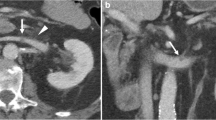Abstract
Background
Penetrating inferior vena caval injuries remain a challenging operative entity. This study reviews our local experience with the injury over a nine-year period and attempts to contextualize it within the published literature that emanates from South Africa on the topic.
Methods
A single-centre retrospective review of prospectively collected data was performed of all patients who underwent a laparotomy for a penetrating IVC injury. Descriptive statistics were calculated for demographics, clinical and biochemical parameters, intraoperative data, ICU admission and outcomes.
Results
During the nine-year period, thirty-five patients sustained penetrating injuries to the IVC. Mechanism of injury included 25 low velocity gunshots (71%) and 10 stab wounds (29%). The anatomical location included two (6%) supra-renal, six (17%) juxta-renal and 27 (77%) infra-renal injuries. Venorrhaphy was performed in 22 cases (63%) and ligation in 13 (37%). Average ICU stay was 5.4 days. Thirteen patients died (37%), of which six (46%) died within 24 h of arrival.
Conclusion
Despite dramatic improvements in surgical trauma care over the last four decades, penetrating injury to the IVC carries a high mortality rate ranging from 31 to 37%. It is unlikely that further improvements can be achieved by refining operative techniques and approaches to resuscitation. Future endeavours must focus on applying the burgeoning understanding of endovascular surgery to these injuries.

Similar content being viewed by others
References
Weale R, Kong V et al (2018) Management of Intra-abdominal vascular injury in trauma laparotomy: a South African Experience. Can J Surg 61(3):158–164
Hansen CJ, Bermadas C et al (2000) Abdominal vena cava injuries: outcomes remain dismal. Surgery 128(4):572–578
Paul JS, Webb TP et al (2010) Intraabdominal vascular injury: Are we getting any better? J Trauma Inj Infect Crit Care 69(6):1393–1397
Rotondo MF, Schwab CW et al (1993) Damage control: an approach for improved surivial in exanguinating penetrating abdominal trauma. J Trauma 35(3):375–382
Boffard KD et al (2019) Management of definitive surgical trauma care, 5th ed. CRC Press, United States
Mattox KL (2004) Top knife: the art & craft of trauma surgery, 1st ed. Castle Hill Barns, Shrewsbury, U.K.
Advanced Trauma Life Support, 10th ed (2018) American College of Surgeons
Robbs JV, Costa M et al (1984) Injuries to the great veins of the abdomen. SAJS 22(4):223–228
Degiannis E, Velmahos C et al (1996) Penetrating injuries of the inferior vena cava. Ann R Coll Surg Engl 78:485–489
Clarke DL, Madiba TE et al (1999) Inferior vena caval injury in the firearm era. SAJS 37(4):107–109
Navsaria P, de Bruyn P et al (2005) Penetrating abdominal vena cava injuries. Eur J Vasc Endovasc Surg 30:499–503
Van Rooyen PL, Karusseit VOL et al (2014) Inferior vena cava injuries: a case series and review of the South African experience. JINJ-5784
Khan MZ, Bruce J et al (2019) Hybrid use of REBOA in a South African tertiary trauma unit for penetrating torso trauma. BMJ Case Rep 12:e229538
Angeles AP, Agarwal N et al (2004) Repair of a juxta-hepatic inferior vena cava injury using a simple endovascular technique. J Trauma Inj Infect Crit Care 56(4):918–921
Castelli P, Caronno R et al (2005) Emergency endovascular repair for traumatic injury of the inferior vena cava. Eur J Cardiothorac Surg 28(6):906–908
Tillman BW, Vaccaro PS et al (2006) Use of an endovascular occlusion balloon for control of unremitting venous hemorrhage. J Vasc Surg 43:399–400
Bui TD, Mills JL et al (2009) Control of inferior vena cava injury using percutaneous balloon catheter occlusion. J Vasc Endovasc Surg 43(5):490–493
Bisulli M, Emiliano G et al (2017) Resuscitative endovascular balloon occlusion of vena cava: an option in managing traumatic vena cava injuries. J Trauma Acute Care Surg 84(1):211–213
Herrero A, Souche R et al (2020) Endovascular balloon occlusion during reconstruction of portal vein injury. Langenbecks Arch Surg 405:391–395
Reynolds CL, Celio AC et al (2017) REBOA for the IVC? Resuscitative balloon occlusion of the inferior vena cava (REBOVC) to abate massive hemorrhage in retrohepatic vena cava injuries. J Trauma Acute Care Surg 83(6):1041–1046
Wikström MB, Krantz J et al (2019) Resuscitative Endovascular balloon occlusion of the inferior vena cava is made haemosynamically possible by concomitant endovascular balloon occlusion of the aorta—a porcine study. J Trauma Acute care 88:3
Author information
Authors and Affiliations
Corresponding author
Ethics declarations
Conflict of interest
The authors do not have any relevant disclosures or conflicts of interest for this work and no funding was utilized either.
Additional information
Publisher's Note
Springer Nature remains neutral with regard to jurisdictional claims in published maps and institutional affiliations.
Rights and permissions
About this article
Cite this article
Khan, M.Z., Khan, A., Mbebe, D.T. et al. Despite Major Therapeutic Advances, Vena Caval Trauma Remains Associated with Significant Morbidity and Mortality. World J Surg 46, 577–581 (2022). https://doi.org/10.1007/s00268-021-06403-x
Accepted:
Published:
Issue Date:
DOI: https://doi.org/10.1007/s00268-021-06403-x




